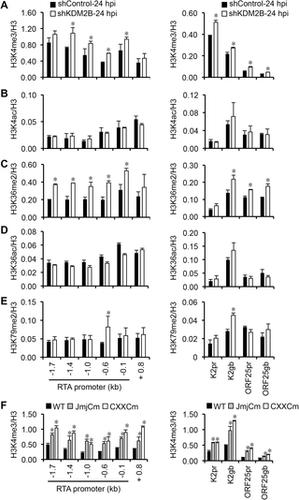当前位置:
X-MOL 学术
›
PLOS Pathog.
›
论文详情
Our official English website, www.x-mol.net, welcomes your
feedback! (Note: you will need to create a separate account there.)
Epigenetic factor siRNA screen during primary KSHV infection identifies novel host restriction factors for the lytic cycle of KSHV.
PLoS Pathogens ( IF 5.5 ) Pub Date : 2020-01-10 , DOI: 10.1371/journal.ppat.1008268 Nenavath Gopal Naik 1 , Thomas Hong Nguyen 1 , Lauren Roberts 1 , Luke Todd Fischer 1 , Katherine Glickman 1 , Gavin Golas 1 , Bernadett Papp 1, 2, 3, 4 , Zsolt Toth 1, 2, 3
PLoS Pathogens ( IF 5.5 ) Pub Date : 2020-01-10 , DOI: 10.1371/journal.ppat.1008268 Nenavath Gopal Naik 1 , Thomas Hong Nguyen 1 , Lauren Roberts 1 , Luke Todd Fischer 1 , Katherine Glickman 1 , Gavin Golas 1 , Bernadett Papp 1, 2, 3, 4 , Zsolt Toth 1, 2, 3
Affiliation

|
Establishment of viral latency is not only essential for lifelong Kaposi's sarcoma-associated herpesvirus (KSHV) infection, but it is also a prerequisite of viral tumorigenesis. The latent viral DNA has a complex chromatin structure, which is established in a stepwise manner regulated by host epigenetic factors during de novo infection. However, despite the importance of viral latency in KSHV pathogenesis, we still have limited information about the repertoire of epigenetic factors that are critical for the establishment and maintenance of KSHV latency. Therefore, the goal of this study was to identify host epigenetic factors that suppress lytic KSHV genes during primary viral infection, which would indicate their role in latency establishment. We performed an siRNA screen targeting 392 host epigenetic factors during primary infection and analyzed which ones affect the expression of the viral replication and transcription activator (RTA) and/or the latency-associated nuclear antigen (LANA), which are viral genes essential for lytic replication and latency, respectively. As a result, we identified the Nucleosome Remodeling and Deacetylase (NuRD) complex, Tip60 and Tip60-associated co-repressors, and the histone demethylase KDM2B as repressors of KSHV lytic genes during both de novo infection and the maintenance of viral latency. Furthermore, we showed that KDM2B rapidly binds to the incoming viral DNA as early as 8 hpi, and can limit the enrichment of activating histone marks on the RTA promoter favoring the downregulation of RTA expression even prior to the polycomb proteins-regulated heterochromatin establishment on the viral genome. Strikingly, KDM2B can also suppress viral gene expression and replication during lytic infection of primary gingival epithelial cells, revealing that KDM2B can act as a host restriction factor of the lytic cycle of KSHV during both latent and lytic infections in multiple different cell types.
中文翻译:

原发性KSHV感染过程中的表观遗传因子siRNA筛选为KSHV的裂解周期确定了新的宿主限制性因子。
建立病毒潜伏期不仅对于终身卡波济氏肉瘤相关疱疹病毒(KSHV)感染至关重要,而且还是病毒肿瘤发生的先决条件。潜在的病毒DNA具有复杂的染色质结构,该结构在从头感染过程中由宿主表观遗传因子逐步调节。然而,尽管病毒潜伏期在KSHV发病机理中很重要,但我们仍然缺乏关于表观遗传因素库的信息,这些表观遗传因素对于KSHV潜伏期的建立和维持至关重要。因此,本研究的目的是确定宿主表观遗传因素,这些因素在初次病毒感染期间抑制溶血性KSHV基因,这将表明它们在潜伏期建立中的作用。我们在原发感染过程中针对392个宿主表观遗传因素进行了siRNA筛选,并分析了哪些因素影响病毒复制和转录激活因子(RTA)和/或潜伏期相关核抗原(LANA)的表达,而这是裂解所必需的病毒基因复制和延迟。结果,我们确定了从新感染和维持病毒潜伏期中,核小体重塑和脱乙酰基酶(NuRD)复合物,Tip60和Tip60相关的共阻遏物以及组蛋白脱甲基酶KDM2B是KSHV裂解基因的阻遏物。此外,我们发现KDM2B早在8 hpi时就迅速结合进入的病毒DNA,甚至可以在病毒基因组上建立多梳状蛋白调控的异染色质之前,限制RTA启动子上激活组蛋白标记的富集,有利于RTA表达的下调。引人注目的是,KDM2B还可以在原发性龈上皮细胞裂解感染期间抑制病毒基因的表达和复制,这表明KDM2B可以在多种不同细胞类型的潜伏性和裂解性感染期间充当KSHV裂解周期的宿主限制因子。
更新日期:2020-01-10
中文翻译:

原发性KSHV感染过程中的表观遗传因子siRNA筛选为KSHV的裂解周期确定了新的宿主限制性因子。
建立病毒潜伏期不仅对于终身卡波济氏肉瘤相关疱疹病毒(KSHV)感染至关重要,而且还是病毒肿瘤发生的先决条件。潜在的病毒DNA具有复杂的染色质结构,该结构在从头感染过程中由宿主表观遗传因子逐步调节。然而,尽管病毒潜伏期在KSHV发病机理中很重要,但我们仍然缺乏关于表观遗传因素库的信息,这些表观遗传因素对于KSHV潜伏期的建立和维持至关重要。因此,本研究的目的是确定宿主表观遗传因素,这些因素在初次病毒感染期间抑制溶血性KSHV基因,这将表明它们在潜伏期建立中的作用。我们在原发感染过程中针对392个宿主表观遗传因素进行了siRNA筛选,并分析了哪些因素影响病毒复制和转录激活因子(RTA)和/或潜伏期相关核抗原(LANA)的表达,而这是裂解所必需的病毒基因复制和延迟。结果,我们确定了从新感染和维持病毒潜伏期中,核小体重塑和脱乙酰基酶(NuRD)复合物,Tip60和Tip60相关的共阻遏物以及组蛋白脱甲基酶KDM2B是KSHV裂解基因的阻遏物。此外,我们发现KDM2B早在8 hpi时就迅速结合进入的病毒DNA,甚至可以在病毒基因组上建立多梳状蛋白调控的异染色质之前,限制RTA启动子上激活组蛋白标记的富集,有利于RTA表达的下调。引人注目的是,KDM2B还可以在原发性龈上皮细胞裂解感染期间抑制病毒基因的表达和复制,这表明KDM2B可以在多种不同细胞类型的潜伏性和裂解性感染期间充当KSHV裂解周期的宿主限制因子。











































 京公网安备 11010802027423号
京公网安备 11010802027423号